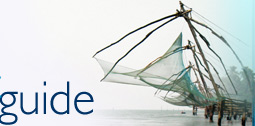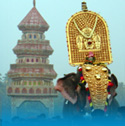Kerala History
In India, mythical legends associate themselves with the origin of a large number of states and Kerala too holds out the same affiliation. According to legends, Parsurama, the sage warrior, was responsible for the creation of Kerala. The story goes that Parsurama, enraged at the killing of his father at the hands of a Kshatriya king, vowed to eliminate entire Kshatriya clan 21 times. However, after completion of his vow, he was full of remorse and sort the advice of learned men to rectify his mistakes. These people asked him to distribute all lands he had acquired from the kings between the Brahmins. Parshuram had no objection as he willingly agreed to do the same and also sat in penance at Gokarnam, which at that point of time was considered the end of land. The sea god Varuna, pleased with Parsurama's dedication offered him land equivalent to the distance he could throw his axe. Parsurama threw his axe with full might from Gokarnam and it fell at Kanyakumari. The sea in this area receded and gave way to what is today known as Kerala.
The Cheras
This legend is not altogether devoid of facts because even geologists believe that the land of Kerala emerged from the elevation of seabed. The first evidence of inhabitation in Kerala dates back to 10th -5th century BCE. However, the first recorded history is seen only in the inscription of the Mauryan Emperor, Ashoka. In those time, the Chera dynasty, also known as the Keralaputra, ruled over Kerala. More detailed information about the history of Kerala is available from Sanagam age, the time when Sangam literature was composed. At that point of time, three major powers occupied parts of Kerala - Ays in the south, the Cheras in Central Kerala and Ezhimalas to the north. Out of all the three, the Cheras were the most powerful
Post Sangam Era & Re-emergence of Cheras
Post the Sangam era, Kerala plunged into a period of darkness which continued for the next four centuries. During this period, the Kalbharas ruled over Kerala. By the end of the eighth century, the Kulbharas were overpowered by the forces of the Pallavas, the Chalukyas, the Rashtrakutas and the Pandyas. It was during this period that the Second Chera dynasty, founded by Kulasekhara Alvar, rose to prominence with their capital in Mahodyapuram (present day Kodangallur). Kulasekhara Alvar was one of the 12 Alvars, Tamil saints who were responsible for propagating the Bhakti cult in South India. Kulasekhara Alvar was succeeded by Rajasekhara Varman Rul who is famed for the issuance of Vazhappali Inscription, the first epigraphical record of the Chera Kingdom. His successor, Sthanu Ravi Varman was on a cordial relation with the Chola King of the time, Aditya. However, after his demise, frequent conflicts between the Chera and Cholas resulted in the splitting up of the Chera Empire. Even their capital at Mahodyapuram was captured by the Cholas.
Venad Rule
From this splitting emerged a new independent kingdom of Venad. The most prominent of the Venad rulers were Udaya Marthanda Varma and Ravi Varma Kulasekhara. The latter not only encouraged the development of art and learning in his own kingdom but also brought in the war ravaged Pandya Empire a wave of peace. Trading activities also took leaps forward and Quilon emerged as a famous business centre. The death of Ravi Varma Kulasekhara was a severe blow to this dynasty as it could not linger on for long and soon after the dynasty lost its significance and fell apart
The Zamorins
During this period Calicut became more important. Ruled by the Zamorins (Lord of Sea) dynasty, Calicut shot into limelight as a major seaport. Trade with China and Arab took new dimensions and art and culture seemed to have got wings. The Zamorins also set about to expand their territory and conquered areas like Beypore, Parappanad, Vettat, Kurumbranad, Nilambur, Manjeri, Malappuram, Kottakal and Ponnai. However, the rulers of Cochin were not ready to be subjugated and hence frequent clash broke out between the two powers.
The Portuguese
With the advent of the Portuguese, things became difficult for the Zamorins as the former received support from the Cochin ruler. Tensions between the Portuguese and Calicut rulers lessened a lot after the arrival of Albuquerque (another Portuguese) but after his death, his successor could not manage the situation as well as him. This led to the decline of Portuguese power in Kerala yet they left behind a significant legacy of Portuguese culture.
The Dutch & the Britishers
By this time, the possibility of great trading relations with India had attracted Dutch and Brithishers as well. Both these powers joined hand to break the Portuguese monopoly and they were successful to a large extent. But then, the rise of Travancore (Venad) ultimately saw the end of the Dutch power in India.
Hyder Ali & Tipu Sultan
Around 1763, Haider Ali, the ruler of Mysore captured the region of Kolathiri, Kottayam, Kadathanad, Kurumbranad and Calicut. By 1773, Haider Ali managed to extend his authority over Malabar as well as Trichur. His son, the famous Tipu Sultan, who succeeded him in 1782, also strengthened his empire and annexed the entire South Malabar region. In 1790s, when Tipu Sultan had barely managed to cross over the Travancore (Venad) territory, the third Mysore war broke out with the British. The kingdoms under Tipu began to bow to the pressures of the British power and he was forced to sign the treaty of Malabar. According to this treaty, Malabar region was given to the British. Under the British, the Malabar region was made into the district of Madras Presidency.
Fight for Independence & Formation of Kerala State
The ruthlessness of the Britishers always invoked revolt from the natives and a sway of leaders led the people to protest against their authority. Post independence, the princely states of Travancore were unified together to form the province of Travancore-Cochin while the Madras Presidency became the Madras state. Finally, in 1956 a new state of Kerala came into being including the regions of Malabar District, Travancore-Cochin, and the taluk of Kasargod, South Kanara
Today, Kerala is one of the prime tourists destination of India and attracts millions of visitors every year. It is also known for its highest percentage of literacy in the entire country.
This article is licensed under the GNU Free Documentation License. It uses material from the Wikipedia and numerous other sources that provide freedom to copy and redistribute content, with or without modifying it, either commercially or noncommercially. |







